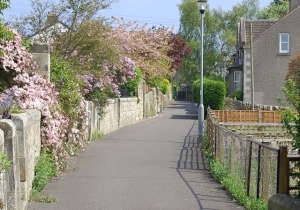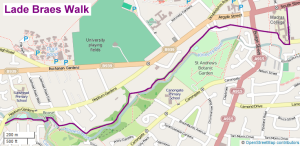The name “Lade Braes” comes from “Lade” or “Lead”,[1] an artificial watercourse created to lead water to where it is needed, usually the mill pond above a water mill, and “Braes”,[2] a northern British term for hillsides or high ground next to a river.
The lade brought water to the Priory of St Andrews but exactly when it was built is unclear. It may have been in existence even before the Priory was founded in 1140[3] since there is some evidence that a mill was there before the Priory.[4] However, the first written reference to the lade does not occur until 1479.[4] With the Priory site being on the high ground of St Andrews, the lade had to stretch west over a mile and a half to reach a spot on the Kinness Burn (or Nether Burn as it was then known) which was above the height of the Priory. This would have been no easy feat of engineering, using primitive tools in medieval times. A weir was built across the burn just below Law Mill and this fed water into the head of the lade. The water was probably for the exclusive use of the two Priory mills, the Abbey Mill and the Shore Mill although a town plan of 1580 shows a watercourse running down the west side of Greenside Place,[5] whose source could have been the lade. A washing mill fed from the lade at the foot of Abbey Street was approved in 1793 but it is not known if the owners, Dempster, Gray & Co ever built it.[4] The lade water eventually reached the harbour at the Shore Mill and at low tide you can still see the square opening at the bottom of the harbour wall where the lade ends.
For most of its life the lade was open and as the water flowed past St Andrews the citizens made use of it for washing clothes, cleaning fish, and possibly for drinking. In fact by 1697, the pollution of the lade and lack of an adequate water supply was one of the concerns which had prompted the university to consider moving to Perth.[6] There were many footbridges over the open lade giving access to the properties on the south side of St Andrews[7] and by 1849 there was already a “Lead Braes Walk” alongside the running water.[8]
Gradually the lade was covered over, the water continuing to flow underground in pipes. One of the first sections to be covered was in the grounds of the newly-built Madras College, around 1845-54.[9] The rest was covered 1856 to 1890 except for a short section near West Burn Lane and at the Abbey Mill pond.[10] In the grounds of St Leonards, Sir Hugh Lyon Playfair had built a series of fountains fed from the lade. The water turned a water wheel which pumped the water up into cisterns and these in turn fed the fountains by gravity.[11]
The upper Lade Braes, from Cockshaugh Park to Law Mill, was landscaped and trees planted at the end of the 1800s under the direction of Town Councillors John McIntosh and then John Milne.[12] By this time Abbey Mill and Shore Mill were no longer in use, Shore Mill stopped in 1897 and Abbey Mill was demolished at around the same time.[4] Memorials to both councillors can be found beside the walk just west of Cockshaugh Park.
A final use for the water flowing in the underground lade was to feed a skating pond[11] which was on the flat area between the lade and the Kinness Burn at Balnacarron.[13] A sluice control is visible at the side of the walk which would have been used to fill the pond ready for winter. The pond seems to have disappeared around the 1950s.
Around 1906, about the same time that the Lade Braes was being established as a recreational area, a curling pond and club house were built[14] in the wooded area near Little Carron.[15] This was replaced by the childrens play area in the 1980s.
Gallery
References
- “Lade” online at Dictionary of the Scots Language
- “Brae” online at Dictionary of the Scots Language
- “St Andrews Cathedral Priory” online at Wikipedia
- R N Smart; “Notes on the Water Mills of St Andrews” (1989) in “Three Decades of Historical Notes” (ed. M Innes & J Whelan, 1991)
- John Geddy; “S. Andre sive Andreapolis Scotiae Universitas Metropolitana” Greenside Place (1580) online at National Library of Scotland
- Rev Charles J Lyon, MA; “The History of St Andrews, Ancient and Modern” (1838) online at Google Books
- John Geddy; “S. Andre sive Andreapolis Scotiae Universitas Metropolitana” lade bridges (1580) online at National Library of Scotland
- Rev Charles Rogers; “History of St Andrews” (1849) online at Google Books
- Ordnance Survey; Town Plan of St Andrews Madras College (1854) online at National Library of Scotland
- Ordnance Survey; Town Plan of St Andrews West Burn Lane (1893) online at National Library of Scotland
- John H Wilson; “Nature Study Rambles Round St Andrews” (1910) online at Forgotten Books
- M Jarron & J Webster; “A Journey Through the Lade Braes” (St Andrews Preservation Trust)
- Ordnance Survey; 6″ series maps Skating Pond (1921) online at National Library of Scotland
- “Plans of proposed curling ponds, Law Mill, St Andrews, Fife” (1906) online at St Andrews University Archives
- Ordnance Survey; 25″ series maps Curling Pond (1914) online at National Library of Scotland























